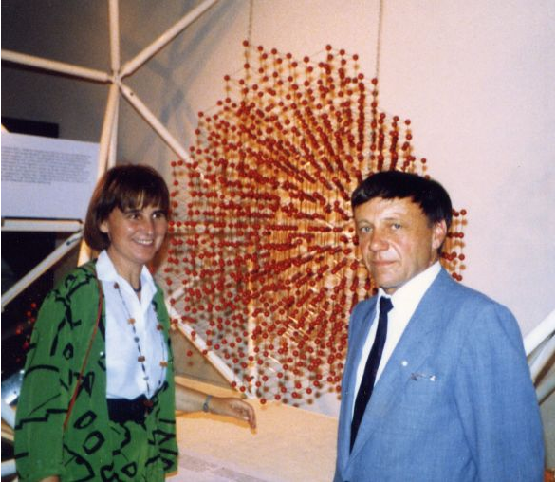1.5 Theory predates discovery of icosahedral long-range order.
The point symmetry of the regular pentagon or the regular icosahedron
is forbidden in a periodic crystal of three-dimensional space. Insisting
on icosahedral point symmetry, we constructed in 1983 a quasiperiodic
long-range repetition pattern with two rhombohedral building blocks and
icosahedral point symmetry. Icosahedral point symmetry in diffraction
was discovered in 1984 and interpreted as aperiodic long-range order in
quasicrystals.
In 1983 I began to study aperiodic tilings obtained by projection. Harald Bohr [2],
[3] pp. 111-125 already in 1925 had presented a geometric analysis of
quasiperiodic functions. He considered a lattice in n-dimensional Euclidean space,
cut by a planar section of dimension m < n, chosen irrational and
so not parallel to any net plane of the lattice. Rational sections
are excluded since they would again be periodic. Bohr showed that the
restriction of a periodic function in n-space to its values on an irrational
section would produce a quasiperiodic function. Starting from a Λ-periodic
function fp(x) defined on all x  En with the property eq. 3, and choosing
an irrational subspace E∥m and a fixed point c
⊥ from the orthogonal
complement E⊥(n-m)
En with the property eq. 3, and choosing
an irrational subspace E∥m and a fixed point c
⊥ from the orthogonal
complement E⊥(n-m)  En, a quasiperiodic function fqp(x
∥) is given as the
restriction of the periodic function to its values on the irrational section,
En, a quasiperiodic function fqp(x
∥) is given as the
restriction of the periodic function to its values on the irrational section,

An idea not discussed by H Bohr was that a non-crystallographic point group
can guide the choice of the irrational section. Bohr’s analysis, contrary
to scaling, provides a Fourier analysis of quasiperiodic functions
and assures that they have a pure point Fourier spectrum, see the
next subsection. An embedding into a high-dimensional lattice was also
introduced by Janner in 1976 [14] to describe what was called modulated
crystals.
N G de Bruijn [5], [6] employed pentagonal point symmetry to construct the
Penrose rhombus tiling by projection from a lattice in 5 dimensions. Together
with my student Roberto Neri I then inquired how the point group of the
icosahedron could be made compatible with an n-dimensional lattice. Our answer,
technically obtained from the theory of induced representations, was an
embedding of icosahedral symmetry into a 6-dimensional hypercubic lattice. This
embedding is already minimal, that is, the standard representation of
the icosahedral group cannot be embedded into a lattice in a space of
dimension smaller than 6. Within 6-dimensional space E6, there is a 3D
linear subspace E3, called the parallel space E3 = E
∥3, such that the
six basis vectors of the hypercubic lattice Z6  E6 project into the six
5-fold axes of the icosahedron. Clearly then this 3-dimensional subspace
is transformed into itself under icosahedral rotations and provides the
physical space for the tiling construction. Any element of the icosahedral
group is presented by a permutation or change of sign of these six axes.
Our work [20] (received on Dec 5, 1983) was published in 1984 before
the discovery of icosahedral quasicrystals by Shechtman et al [45]. We
constructed two icosahedral tiles in the shape of rhombohedra as projections
of 3-dimensional boundaries of the 6-dimensional hypercube. The 3D
projection of this hypercube is Kepler’s triacontahedron [16]. The two
rhombohedral tiles are shown in the left lower part of Fig. 10. The tiling
was constructed from a hexagrid as described in detail in [24]. In this
way we built the first 3-dimensional icosahedral tiling model by
projection. This tiling in our present terminology would be denoted as
(
E6 project into the six
5-fold axes of the icosahedron. Clearly then this 3-dimensional subspace
is transformed into itself under icosahedral rotations and provides the
physical space for the tiling construction. Any element of the icosahedral
group is presented by a permutation or change of sign of these six axes.
Our work [20] (received on Dec 5, 1983) was published in 1984 before
the discovery of icosahedral quasicrystals by Shechtman et al [45]. We
constructed two icosahedral tiles in the shape of rhombohedra as projections
of 3-dimensional boundaries of the 6-dimensional hypercube. The 3D
projection of this hypercube is Kepler’s triacontahedron [16]. The two
rhombohedral tiles are shown in the left lower part of Fig. 10. The tiling
was constructed from a hexagrid as described in detail in [24]. In this
way we built the first 3-dimensional icosahedral tiling model by
projection. This tiling in our present terminology would be denoted as
( ,Z6).
,Z6).
A model of this icosahedral tiling with rhombohedral tiles we constructed in 1985,
with substantial computational and technical help by L. Kramer, and in
collaboration with H. Weitzel, TU Darmstadt. The model (see picture)
was presented at the exhibition Symmetrie in Kunst, Natur und
Wissenschaft, Mathildenhöhe Darmstadt 1986, see [39] Band 3 p.
91.
In 1984, Shechtman et al in [45] (received on Oct 9, 1984), reported the
experimental discovery of material with sharp diffraction peaks of
icosahedral point symmetry and interpreted it as evidence for
long-range non-periodic order. Developments of the field of quasicrystals are
described in [41], [28] and [12].
 En with the property eq. 3, and choosing
an irrational subspace E∥m and a fixed point c
⊥ from the orthogonal
complement E⊥(n-m)
En with the property eq. 3, and choosing
an irrational subspace E∥m and a fixed point c
⊥ from the orthogonal
complement E⊥(n-m)  En, a quasiperiodic function fqp(x
∥) is given as the
restriction of the periodic function to its values on the irrational section,
En, a quasiperiodic function fqp(x
∥) is given as the
restriction of the periodic function to its values on the irrational section,


